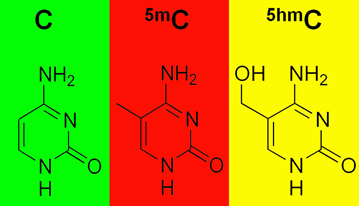Methylation, an epigenetic modification to DNA, can be thought of as a highlighting pen applied to DNA’s text, adding information but not changing the actual letters of the text.
Are you still with me on the metaphors? If so, consider this wrinkle. (If not, more explanation here.)
Emory geneticist Peng Jin and his colleagues have been a key part of the discovery in the last few years that methylation comes in several colors. His lab has been mapping where 5-hydroxymethylcytosine or 5hmC appears in the genome and inferring how it functions. 5-hmC is particularly abundant in the brain.
Methylation, in the form of 5-methylcytosine or 5mC, is both a control button for turning genes off and a sign of their off state. 5hmC looks like 5mC, except it has an extra oxygen. That could be a tag for a removal, or a signal that a gene is poised to be turned on.
Two recent papers on this topic:
Please recall that an enriched environment (exercise and mental stimulation) is good for learning and memory, for young and old. In the journal Genomics, Jin and his team show that exposing mice to an enriched environment — a running wheel and a variety of toys — leads to a 60 percent reduction in 5hmC in the hippocampus, a region of the brain critical for learning and memory.  The changes in 5hmC were concentrated in genes having to do with axon guidance. Hat tip to the all-things-epigenetic site Epigenie.
In Genes and Development, structural biologist Xiaodong Cheng and colleagues demonstrate that two regulatory proteins that bind DNA (Egr1 and WT1) respond primarily to oxidation of their target sequences rather than methylation. These proteins like plain old C and 5mC equally, but they don’t like 5hmC or other oxidized forms of 5mC. “Gene activity could plausibly be controlled on a much finer scale by these modifications than simply ‘on or ‘off’,†the authors write.





![queen_bee_04~s600x600[1]](http://www.emoryhealthsciblog.com/wp-content/uploads/2010/01/queen_bee_04s600x6001-150x150.jpg)